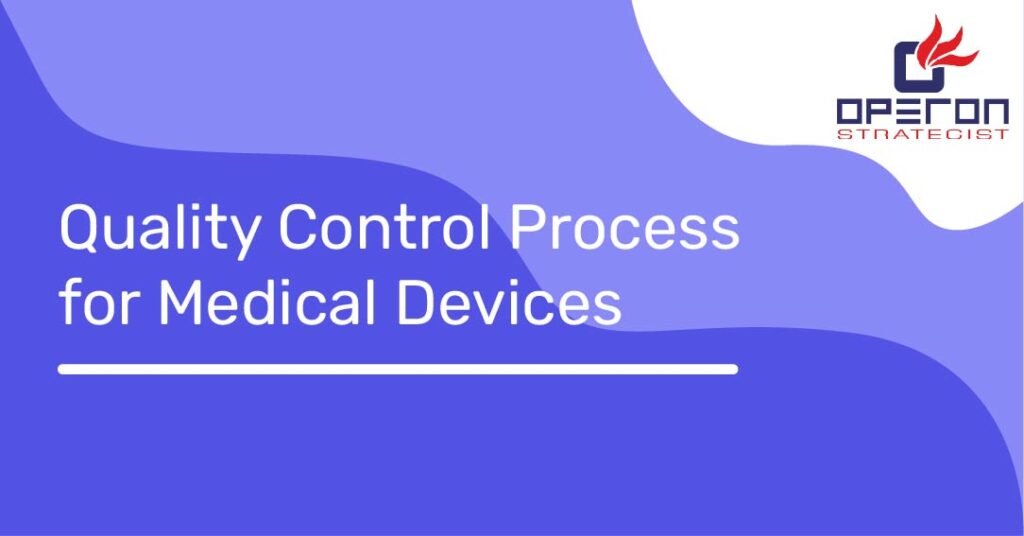Overview - Quality Control Process
Medical devices have a direct or indirect impact on the lives of their users. The reason there is a need for understanding the quality control process for medical devices is that manufacturers want to be sure of the medical devices and their effectiveness. The main target of any medical device is to improve the lives of its users. But what if a product fails to perform as it should? What happens if a device fails or harms a patient? How can we be certain that medical devices work well and are safe to use?
Looking For Medical Device Regulatory Consultants?
Let’s have a word about your next project
The necessity for a Quality Management System (QMS) arises. When medical devices are made, they must be thoroughly examined using appropriate measures as part of a Quality Control system of which the Quality Control process is an essential component. Let’s take a closer look at what Quality Control means for medical devices, why it’s important, and how to improve your own medical device Quality Control process.
- Operon strategists is leading regulatory medical device consulting.
- We provides QMS certification services including training, layout designing, executing and maintaining all features.
- Looking Forward To QMS Certification Consultant For Medical Devices ? Contact Us Or Whatapps
What Does a Quality Control Process for Medical Devices Look like?
According to the definition, the Quality Control process for medical device is reactive as well as product-oriented. These operations take place in manufacturing both during and after production, as well as before products are distributed to customers. A Quality Control procedure checks that individual product or batches of a product meet product specifications and are free of flaws or defects. Quality Control department in medical device manufacturing utilize a number of procedures and metrics to identify nonconforming items. Any Quality Control approach should concentrate on three primary areas:
Acceptance criteria: The FDA requires Quality Control personnel to create a formal document outlining how they will decide if products meet product standards. Quality Control personnel are also in charge of documenting stated acceptance and keeping track of which items or batches did and did not meet the standards.
Product inspection, testing and verification: Quality Control personnel are supposed to inspect, test, and verify if a product is ready for shipment. Medical device manufacturers have the ability to design their own Quality Control tests under FDA\’s quality system regulation, but FDA wants extensive documentation that confirms the verification’s performance.
Corrective and preventive action (CAPA) management: When Quality Control personnel detect a nonconforming product, conduct a root cause investigation, and discover a systemic defect that caused the non – conformance, these investigative events are initiated.
Who is Involved in Quality Control Process for Medical Device?
Quality Control, according to ISO 9001, is “A aspect of quality management focused on meeting quality requirements.” The international standard goes on to list essential Quality Control process requirements, one of which is competence, which includes staff knowledge, skills, experience, and certifications.
The primary role of quality control professionals is inspection, such as to check devices for cracks or broken components. Medical devices are complex; to ensure that these products are not defective requires a team of trained, competent and diligent inspectors, equipped with an extensive knowledge as dictated by the aforementioned acceptance criteria document.
Quality Control VS Quality Assurance
Quality control and quality assurance both are part of same quality management system, their roles and responsibilities are not much different. Quality assurance prevents defects in the manufacturing process of medical device. Quality assurance act throughout the medical device manufacturing process. Quality personnel look for problems in processes that might result in nonconforming products.
For quality control, however, the main concern is the product rather than the process. Quality control testing doesn’t start until a batch or lot of medical devices is ready for shipment, at which time this specialized team is responsible for inspecting and giving final review of the batch or lot to ensure that the devices are ready for sale.
How to Evaluate your Own Quality Control Process?
Every medical device manufacturer needs to be thinking carefully about how it approaches quality. The quality planning can be carried out in many ways, such as with high-level ideas about quality management or the establishment of an actual quality system.
Activities like onsite inspections of physical product are often more tangible. So, what exactly one should look while evaluating own medical device company’s quality control process?
- Establish a quality management plan
Specifically, ISO 13485 requires the development of a quality management plan, a document which defines the, “quality practices, resources and activities relevant to devices that are designed and manufactured.” It will help to spread light on what is being tested by quality control, how the roles of quality control fit within the entire QMS and which responsibilities are required for each team member and department.
- Collaboration with product developers for quality control insights
Quality control methods can be considerably enhanced by addressing device specifics with the design team, in the same spirit of collaboration. Few people know a product’s inner workings better than its engineers, and they’ll be able to explain device inputs and point out any flaws in your quality control testing.
- Write descriptive acceptance requirements
Establishing effective acceptance criteria is at the heart of the quality control process. Because this document contains explicit standards for a device to be judged fit-for-sale, it’s critical to assess the language used to define the features your quality control team is evaluating. Requirements should be defined clearly and plainly, but they should also prevent information overload, which could lead to testers flagging a product as nonconforming unnecessarily.
- Create thorough documentation
Documentation, like every other aspect of the medical device life cycle, is critical to the quality control process. This is evidenced by regulatory requirements such as the FDA’s 21 CFR Part 11, which calls for quality control testing paperwork. It’s also critical that you keep track of the inevitable modifications that occur during the device’s lifecycle. Make sure you’re using a traceability matrix to track all design changes, inputs, outputs, and user requirements. Your acceptance criteria may be affected by changes in your traceability. Keep track of any changes to the acceptance criteria and make sure that quality control personnel are trained on the new procedures.
The above discussed points give us idea about Quality control process for medical devices. Quality control process for medical devices is necessary for the safety for public health as the devices directly or indirectly used by the patients.






